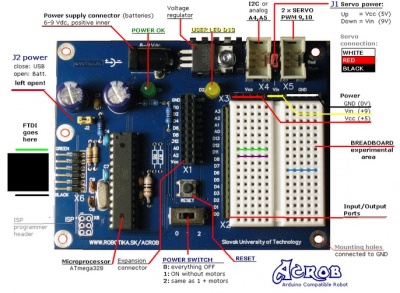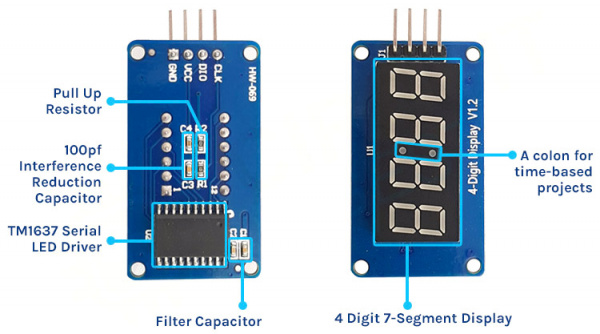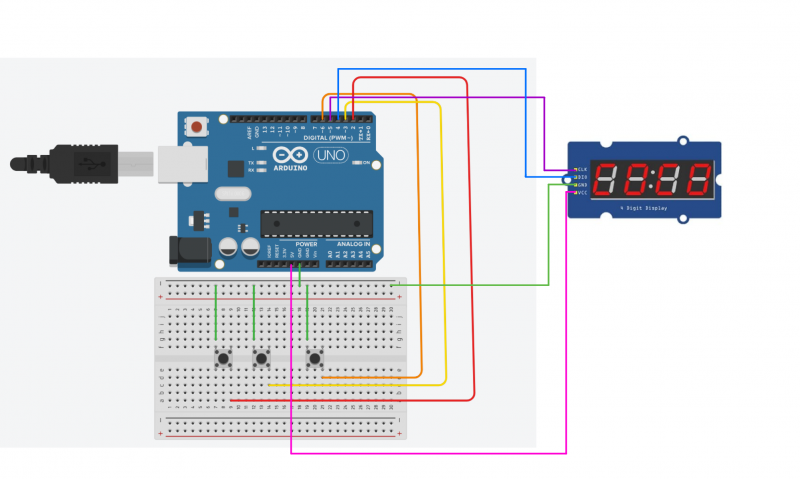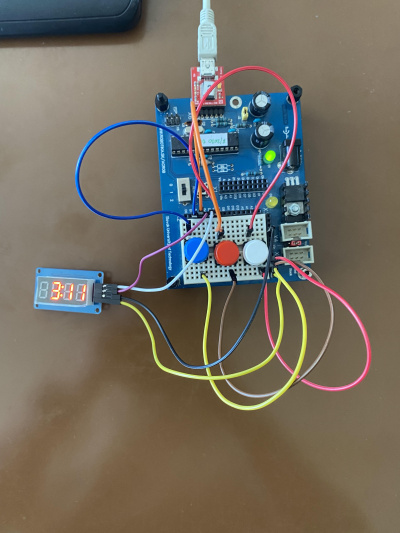7-segmentový displej na futbal: Rozdiel medzi revíziami
Zo stránky SensorWiki
| (30 medziľahlých úprav od rovnakého používateľa nie je zobrazených.) | |||
| Riadok 10: | Riadok 10: | ||
'''Literatúra:''' | '''Literatúra:''' | ||
* [http://ap.urpi.fei.stuba.sk/sensorwiki/index.php/Acrob_technical_description Dokumentácia k doske Acrob] | * [http://ap.urpi.fei.stuba.sk/sensorwiki/index.php/Acrob_technical_description Dokumentácia k doske Acrob] | ||
* [https://github.com/avishorp/TM1637 Dokumentacia k TM1637 displeji] | |||
* [https://github.com/TeWu/TM1637 Kniznice k TM1637 displeji] | |||
| Riadok 18: | Riadok 20: | ||
Princíp fungovania bol jednoduchý, ak stlačíme tlačidlo príslušné k prvému tímu, meníme skóre prvého tímu a ak stlačíme tlačidlo príslušné k druhému tímu, meníme skóre druhého tímu. Takisto máme tlačidlo RESET, ktoré celé skóre resetuje. Na správne fungovanie sme si vytvorili knižnicu, v ktorej sme zadefinovali čísla od 0-9 pomocou zapnutých a vypnutých segmentov na 7 segmentovke. | Princíp fungovania bol jednoduchý, ak stlačíme tlačidlo príslušné k prvému tímu, meníme skóre prvého tímu a ak stlačíme tlačidlo príslušné k druhému tímu, meníme skóre druhého tímu. Takisto máme tlačidlo RESET, ktoré celé skóre resetuje. Na správne fungovanie sme si vytvorili knižnicu, v ktorej sme zadefinovali čísla od 0-9 pomocou zapnutých a vypnutých segmentov na 7 segmentovke. | ||
[[Súbor:TM1637-Display-Module-Parts.jpg| | [[Súbor:TM1637-Display-Module-Parts.jpg|600px|thumb|center|TM1637 displej]] | ||
[[Súbor:zapojenie_futbal.jpg| | [[Súbor:zapojenie_futbal.jpg|800px|thumb|center|Schéma zapojenia TM1637 7 segmentového displeja]] | ||
=== Algoritmus a program === | === Algoritmus a program === | ||
Tento program sme vytvorili na ovládanie 7 segmentového displeja pomocou tlačidiel a následného zobrazovania futbalového skóre pomocou tlačidiel. Najprv sme si vytvorili knižnicu do ktorej sme uložili čísla od 0-9 na zobrazenie čísiel pomocou svietiacich a zhasnutých segmentov. Následne sme si vytvorili funkcie na zapnutie a vypnutie komunikácie. Potom sme si vytvorili funkcie na inicializáciu, nastavenie segmentov a ich následné zobrazenie. Všetky tieto funkcie sme uložili do uart.c (resp. SemProj_uart.c). | |||
Nakoniec sme pre INT0 a INT1 spravili funkcie, jedna pre ľavú stranu a druhá pre pravú stranu, v ktorých po stlačení tlačidla nastalo zvýšenie hodnoty o 1, kde ak sme dosiahli číslo 99 a zvýšili sme ho, číslo sa nám resetovalo naspäť na 0, keďže na číselné hodnoty sme mali iba 2 7 - segmentové displeje. Keď sme mali všetky tieto funkcie zadefinované, v hlavnej časti programu sme CLK, DIO aj všetky ostatné piny nastavili opäť ako input, povolili sme INT0 a INT1 takisto sei(). | |||
Následne vo while funkcii sme už len dané čísla, ktoré boli uložené v counter_left a counter_right zobrazovali pomocou našej funkcie pre zobrazenie čísla na 7 segmentovke, kde sme pozíciu čísel nastavili na pravú 7 segmentovku z dvojice (čiže celkovo 2. a 4. 7 segmentovka) a po zvýšení čísla na 10 a viac sa začali využívať obe 7 segmentové displeje pre daný tím. Po stlačení tlačidla RESET sa hodnoty v counter_left a counter_right vynulovali a opäť sa využívali iba pravé 7 segmentovky z dvojice. Takto to funguje donekonečna. | |||
<tabs> | <tabs> | ||
<tab name="SemProj"><source lang="c++" style="background: LightYellow;"> | <tab name="SemProj"><source lang="c++" style="background: LightYellow;"> | ||
// Required libraries | // Required libraries | ||
#include <avr/io.h> | #include <avr/io.h> | ||
#include <util/delay.h> | #include <util/delay.h> | ||
#include <avr/interrupt.h> | #include <avr/interrupt.h> | ||
#include "uart.h" | |||
#define CLK PD5 // CLK -> pin 5 | |||
#define DIO PD4 // DIO -> pin 4 | |||
#define set_bit(ADDRESS,BIT) (ADDRESS |= (1<<BIT)) | #define set_bit(ADDRESS,BIT) (ADDRESS |= (1<<BIT)) | ||
#define clear_bit(ADDRESS,BIT) (ADDRESS &= ~(1<<BIT)) | #define clear_bit(ADDRESS,BIT) (ADDRESS &= ~(1<<BIT)) | ||
#define LEFT_START_STOP_PIN PD2 // Tlacidlo pre lavy tim | |||
#define RIGHT_START_STOP_PIN PD3 // Tlacidlo pre pravy tim | |||
#define RESTART_PIN PD6 // Tlacidlo na vynulovanie skore | |||
volatile uint8_t count_left = 0; // Pocitadlo skore pre lavu dvojicu 7 segmentoviek | |||
volatile uint8_t count_right = 0; // Pocitadlo skore pre pravu dvojicu 7 segmentoviek | |||
// External interrupt 0 (Tlacidlo pre lavy tim) | |||
ISR (INT0_vect) | |||
{ | |||
_delay_ms(10); | |||
if(bit_is_clear(PIND, LEFT_START_STOP_PIN)){ | |||
// Zvysuje skore laveho time a pri dosiahnuti hodnoty 100 zresetuje hodnotu na 0 | |||
count_left++; | |||
if (count_left >= 100) count_left = 0; | |||
} | |||
_delay_ms(150); | |||
} | |||
// External interrupt 1 (tlacidlo pre pravy tim) | |||
ISR (INT1_vect) | |||
{ | |||
_delay_ms(10); | |||
if(bit_is_clear(PIND, RIGHT_START_STOP_PIN)){ | |||
// Zvysuje skore praveho time a pri dosiahnuti hodnoty 100 zresetuje hodnotu na 0 | |||
count_right++; | |||
if (count_right >= 100) count_right = 0; | |||
} | |||
_delay_ms(150); | |||
} | |||
int main(void){ | |||
clear_bit(DDRD, CLK); // Nastavenie CLK ako input | |||
set_bit(PORTD, CLK); // CLK ako input pull-up on | |||
clear_bit(DDRD, DIO); // Nastavenie DIO ako input | |||
set_bit(PORTD, DIO); // DIO ako input pull-up o | |||
clear_bit(DDRD, LEFT_START_STOP_PIN); // Nastavenie LEFT_START_STOP_PIN ako input | |||
set_bit(PORTD, LEFT_START_STOP_PIN); // LEFT_START_STOP_PIN ako input pull-up on | |||
clear_bit(DDRD, RIGHT_START_STOP_PIN); // Nastavenie RIGHT_START_STOP_PIN ako input | |||
set_bit(PORTD, RIGHT_START_STOP_PIN); // RIGHT_START_STOP_PIN ako input pull-up on | |||
clear_bit(DDRD, RESTART_PIN); // Nastavenie RESET_PIN ako input | |||
set_bit(PORTD, RESTART_PIN); // RESET_PIN ako input pull-up on | |||
uint8_t data[] = { 0, 0, 0, 0 }; | |||
set_segments(data, 4, 0); | |||
EIMSK = 0b00000011; // Povolenie INT0, INT1 | |||
EICRA = 0b00001010; // Zaznamenanie dobeznej hrany na oboch pinoch | |||
sei(); // Povolit prerusenia | |||
while (1) { | |||
if (bit_is_clear(PIND, RESTART_PIN)) { | |||
// Spusti reset | |||
count_left = 0; // Resetuje skore laveho timu | |||
count_right = 0; // Resetuje skore praveho timu | |||
} | |||
// Zobrazenie skore laveho timu na lavych 2 7 segmentovkach a skore praveho timu na pravych 2 7 segmentovkach | |||
display_number_segment(count_right, 0, 2, 2); | |||
display_number_segment(count_left, 0, 2, 0); | |||
} | |||
return 0; | |||
} | |||
</source></tab> | |||
<tab name="SemProj_uart.c"><source lang="c++" style="background: LightYellow;"> | |||
#include <avr/io.h> | |||
#include <util/delay.h> | |||
#include "uart.h" | |||
#define CLK PD5 // CLK -> pin 5 portD.5 | #define CLK PD5 // CLK -> pin 5 portD.5 | ||
#define DIO PD4 // DIO -> pin 4 portD.4 | #define DIO PD4 // DIO -> pin 4 portD.4 | ||
#define BIT_DELAY 100 // Delay 100ms | #define BIT_DELAY 100 // Delay 100ms | ||
| Riadok 59: | Riadok 155: | ||
#define TM1637_I2C_COMM3 0x80 | #define TM1637_I2C_COMM3 0x80 | ||
// 7 | // Nastavenie cisiel na 7 segmentovom displeji | ||
const uint8_t digitToSegment[] = { | const uint8_t digitToSegment[] = { | ||
// XGFEDCBA | // XGFEDCBA | ||
| Riadok 79: | Riadok 175: | ||
0b01110001 // F | 0b01110001 // F | ||
}; | }; | ||
uint8_t brightness = (0x7 & 0x7) | 0x08; | uint8_t brightness = (0x7 & 0x7) | 0x08; | ||
static const uint8_t minusSegments = 0b01000000; | |||
int inicialize_bit(uint8_t byte){ | int inicialize_bit(uint8_t byte){ | ||
| Riadok 117: | Riadok 192: | ||
// Set data bit | // Set data bit | ||
if (data & 0x01){ | if (data & 0x01){ | ||
clear_bit(DDRD, DIO); // | clear_bit(DDRD, DIO); // Nastavenie DIO ako input | ||
set_bit(PORTD, DIO); // DIO | set_bit(PORTD, DIO); // DIO ako input pull-up on | ||
} else{ | } else{ | ||
set_bit(DDRD, DIO); // | set_bit(DDRD, DIO); // Nastavenie DIO ako output | ||
clear_bit(PORTD, DIO); // | clear_bit(PORTD, DIO); // Nastavenie DIO low | ||
} | } | ||
| Riadok 127: | Riadok 202: | ||
// CLK high | // CLK high | ||
clear_bit(DDRD, CLK); // | clear_bit(DDRD, CLK); // Nastavenie CLK ako input | ||
set_bit(PORTD, CLK); // CLK | set_bit(PORTD, CLK); // CLK ako input pull-up on | ||
_delay_us(BIT_DELAY); | _delay_us(BIT_DELAY); | ||
data = data >> 1; | data = data >> 1; | ||
| Riadok 135: | Riadok 210: | ||
// Wait for acknowledge | // Wait for acknowledge | ||
// CLK to zero | // CLK to zero | ||
set_bit(DDRD, CLK); // | set_bit(DDRD, CLK); // Nastavenie CLK ako output | ||
clear_bit(PORTD, CLK); // | clear_bit(PORTD, CLK); // Nastavenie CLK low | ||
clear_bit(DDRD, DIO); // | clear_bit(DDRD, DIO); // Nastavenie DIO ako input | ||
set_bit(PORTD, DIO); // DIO | set_bit(PORTD, DIO); // DIO ako input pull-up on | ||
_delay_us(BIT_DELAY); | _delay_us(BIT_DELAY); | ||
// CLK to high | // CLK to high | ||
clear_bit(DDRD, CLK); // | clear_bit(DDRD, CLK); // Nastavenie CLK ako input | ||
set_bit(PORTD, CLK); // | set_bit(PORTD, CLK); // Nastavenie CLK high | ||
_delay_us(BIT_DELAY); | _delay_us(BIT_DELAY); | ||
uint8_t ack = !bit_is_clear(PIND, DIO); | uint8_t ack = !bit_is_clear(PIND, DIO); | ||
if (ack == 0) | if (ack == 0) | ||
set_bit(DDRD, DIO); // | set_bit(DDRD, DIO); // Nastavenie DIO ako output | ||
clear_bit(PORTD, DIO); // | clear_bit(PORTD, DIO); // Nastavenie DIO low | ||
_delay_us(BIT_DELAY); | _delay_us(BIT_DELAY); | ||
set_bit(DDRD, CLK); // | set_bit(DDRD, CLK); // Nastavenie CLK ako output | ||
clear_bit(PORTD, CLK); // | clear_bit(PORTD, CLK); // Nastavenie CLK low | ||
_delay_us(BIT_DELAY); | _delay_us(BIT_DELAY); | ||
return ack; | return ack; | ||
} | } | ||
void comunication_start(){ | |||
set_bit(DDRD, DIO); // Nastavenie DIO ako output | |||
clear_bit(PORTD, DIO); // Nastavenie DIO ako output | |||
_delay_us(BIT_DELAY); | |||
} | |||
void comunication_stop(){ | |||
set_bit(DDRD, DIO); // Nastavenie DIO ako output | |||
clear_bit(PORTD, DIO); // Nastavenie DIO ako output | |||
_delay_us(BIT_DELAY); | |||
clear_bit(DDRD, CLK); // Nastavenie CLK ako input | |||
set_bit(PORTD, CLK); // CLK ako input pull-up on | |||
_delay_us(BIT_DELAY); | |||
clear_bit(DDRD, DIO); // Nastavenie DIO ako input | |||
set_bit(PORTD, DIO); // DIO ako input pull-up on | |||
_delay_us(BIT_DELAY); | |||
} | |||
void displayShowDots(uint8_t dots, uint8_t* digits){ | void displayShowDots(uint8_t dots, uint8_t* digits){ | ||
| Riadok 167: | Riadok 264: | ||
} | } | ||
void | |||
// Funkcia na zobrazenie cisla | |||
void display_middle_dots(int num, uint8_t dots, const int leading_zero, uint8_t length, uint8_t pos){ | |||
display_number(num < 0? -10 : 10, num < 0? -num : num, dots, leading_zero, length, pos); | |||
} | } | ||
// Funkcia na zobrazenie cisla v danom zaklade | |||
// | void display_number(int8_t base, uint16_t num, uint8_t dots, const int leading_zero, uint8_t length, uint8_t pos) | ||
void display_number(int8_t base, uint16_t num, uint8_t dots, const int leading_zero, | |||
{ | { | ||
int negative = 0; // False | int negative = 0; // False | ||
| Riadok 203: | Riadok 282: | ||
if (num == 0 && !leading_zero) { | if (num == 0 && !leading_zero) { | ||
for(uint8_t i = 0; i < (length-1); i++) | for(uint8_t i = 0; i < (length-1); i++) | ||
digits[i] = 0; | digits[i] = 0; | ||
| Riadok 214: | Riadok 292: | ||
if (digit == 0 && num == 0 && leading_zero == 0) | if (digit == 0 && num == 0 && leading_zero == 0) | ||
digits[i] = 0; | digits[i] = 0; | ||
else | else | ||
| Riadok 236: | Riadok 313: | ||
} | } | ||
// | // Funkcia na zobrazenie cisla s default nastaveniami | ||
void display_number_segment(int num, const int leading_zero, uint8_t length, uint8_t pos){ | void display_number_segment(int num, const int leading_zero, uint8_t length, uint8_t pos){ | ||
display_middle_dots(num, 0x40, leading_zero, length, pos); | display_middle_dots(num, 0x40, leading_zero, length, pos); | ||
} | } | ||
void set_segments(const uint8_t segments[], uint8_t length, uint8_t pos){ | |||
// Zapis COMM1 | |||
comunication_start(); | |||
inicialize_bit(TM1637_I2C_COMM1); | |||
comunication_stop(); | |||
// Zapis COMM2 + prvu cislicu adresy | |||
comunication_start(); | |||
inicialize_bit(TM1637_I2C_COMM2 + (pos & 0x03)); | |||
// Zapis datove bajty | |||
for (uint8_t k=0; k < length; k++) | |||
inicialize_bit(segments[k]); | |||
comunication_stop(); | |||
// Zapis COMM3 + brightness | |||
comunication_start(); | |||
inicialize_bit(TM1637_I2C_COMM3 + (brightness & 0x0f)); | |||
comunication_stop(); | |||
} | |||
</source></tab> | |||
<tab name="SemProj_uart.h"><source lang="c++" style="background: LightYellow;"> | |||
#define set_bit(ADDRESS,BIT) (ADDRESS |= (1<<BIT)) | |||
#define clear_bit(ADDRESS,BIT) (ADDRESS &= ~(1<<BIT)) | |||
#ifndef UART_H_ | |||
#define UART_H_ | |||
void comunication_start(); | |||
void comunication_stop(); | |||
void displayShowDots(uint8_t dots, uint8_t* digits); | |||
int inicialize_bit(uint8_t byte); | |||
void display_middle_dots(int num, uint8_t dots, const int leading_zero, uint8_t length, uint8_t pos); | |||
void display_number(int8_t base, uint16_t num, uint8_t dots, const int leading_zero, uint8_t length, uint8_t pos); | |||
void display_number_segment(int num, const int leading_zero, uint8_t length, uint8_t pos); | |||
void set_segments(const uint8_t segments[], uint8_t length, uint8_t pos); | |||
#endif /* UART_H_ */ | |||
</source></tab> | |||
</tabs> | </tabs> | ||
Zdrojový kód: [[Médiá:SemProj_Žula.zip|zdrojaky.zip]] | |||
Zdrojový kód: [[Médiá: | |||
=== Overenie === | === Overenie === | ||
| Riadok 337: | Riadok 371: | ||
Na zobrazovanie aktuálneho skóre používame dve tlačidlá, jedným, ktorý je vľavo meníme skóre tímu vľavo, a druhým, ktorý je v strede meníme skóre tímu ktorý je napravo, posledným tlačidlom ktoré je vpravo skóre resetujeme. | Na zobrazovanie aktuálneho skóre používame dve tlačidlá, jedným, ktorý je vľavo meníme skóre tímu vľavo, a druhým, ktorý je v strede meníme skóre tímu ktorý je napravo, posledným tlačidlom ktoré je vpravo skóre resetujeme. | ||
[[Súbor:projektfoto.jpg|400px|thumb|center| | [[Súbor:projektfoto.jpg|400px|thumb|center|Zapojenie 7 - segmentového displeja pre zobrazenie futbalového skóre spolu s tlačidlami]] | ||
'''Video:''' | '''Video:''' | ||
<center><youtube>nTv-t7sA78s</youtube></center> | <center><youtube>nTv-t7sA78s</youtube></center> | ||
[[Category:AVR]] [[Category:MIPS]] | [[Category:AVR]] [[Category:MIPS]] | ||
Aktuálna revízia z 13:47, 6. máj 2024
Záverečný projekt predmetu MIPS / LS2024 - Daniel Žula
Zadanie
Pripojenie 7 - segmentového LED displeja k vývojovej doske, vytvorenie potrebných knižníc a funkcií. Cieľom je, aby sme dokázali zobraziť skóre futbalového zápasu, ktoré dokážeme meniť podľa potreby pomocou tlačidiel.

Literatúra:
Analýza a opis riešenia
Princíp fungovania bol jednoduchý, ak stlačíme tlačidlo príslušné k prvému tímu, meníme skóre prvého tímu a ak stlačíme tlačidlo príslušné k druhému tímu, meníme skóre druhého tímu. Takisto máme tlačidlo RESET, ktoré celé skóre resetuje. Na správne fungovanie sme si vytvorili knižnicu, v ktorej sme zadefinovali čísla od 0-9 pomocou zapnutých a vypnutých segmentov na 7 segmentovke.


Algoritmus a program
Tento program sme vytvorili na ovládanie 7 segmentového displeja pomocou tlačidiel a následného zobrazovania futbalového skóre pomocou tlačidiel. Najprv sme si vytvorili knižnicu do ktorej sme uložili čísla od 0-9 na zobrazenie čísiel pomocou svietiacich a zhasnutých segmentov. Následne sme si vytvorili funkcie na zapnutie a vypnutie komunikácie. Potom sme si vytvorili funkcie na inicializáciu, nastavenie segmentov a ich následné zobrazenie. Všetky tieto funkcie sme uložili do uart.c (resp. SemProj_uart.c).
Nakoniec sme pre INT0 a INT1 spravili funkcie, jedna pre ľavú stranu a druhá pre pravú stranu, v ktorých po stlačení tlačidla nastalo zvýšenie hodnoty o 1, kde ak sme dosiahli číslo 99 a zvýšili sme ho, číslo sa nám resetovalo naspäť na 0, keďže na číselné hodnoty sme mali iba 2 7 - segmentové displeje. Keď sme mali všetky tieto funkcie zadefinované, v hlavnej časti programu sme CLK, DIO aj všetky ostatné piny nastavili opäť ako input, povolili sme INT0 a INT1 takisto sei().
Následne vo while funkcii sme už len dané čísla, ktoré boli uložené v counter_left a counter_right zobrazovali pomocou našej funkcie pre zobrazenie čísla na 7 segmentovke, kde sme pozíciu čísel nastavili na pravú 7 segmentovku z dvojice (čiže celkovo 2. a 4. 7 segmentovka) a po zvýšení čísla na 10 a viac sa začali využívať obe 7 segmentové displeje pre daný tím. Po stlačení tlačidla RESET sa hodnoty v counter_left a counter_right vynulovali a opäť sa využívali iba pravé 7 segmentovky z dvojice. Takto to funguje donekonečna.
// Required libraries
#include <avr/io.h>
#include <util/delay.h>
#include <avr/interrupt.h>
#include "uart.h"
#define CLK PD5 // CLK -> pin 5
#define DIO PD4 // DIO -> pin 4
#define set_bit(ADDRESS,BIT) (ADDRESS |= (1<<BIT))
#define clear_bit(ADDRESS,BIT) (ADDRESS &= ~(1<<BIT))
#define LEFT_START_STOP_PIN PD2 // Tlacidlo pre lavy tim
#define RIGHT_START_STOP_PIN PD3 // Tlacidlo pre pravy tim
#define RESTART_PIN PD6 // Tlacidlo na vynulovanie skore
volatile uint8_t count_left = 0; // Pocitadlo skore pre lavu dvojicu 7 segmentoviek
volatile uint8_t count_right = 0; // Pocitadlo skore pre pravu dvojicu 7 segmentoviek
// External interrupt 0 (Tlacidlo pre lavy tim)
ISR (INT0_vect)
{
_delay_ms(10);
if(bit_is_clear(PIND, LEFT_START_STOP_PIN)){
// Zvysuje skore laveho time a pri dosiahnuti hodnoty 100 zresetuje hodnotu na 0
count_left++;
if (count_left >= 100) count_left = 0;
}
_delay_ms(150);
}
// External interrupt 1 (tlacidlo pre pravy tim)
ISR (INT1_vect)
{
_delay_ms(10);
if(bit_is_clear(PIND, RIGHT_START_STOP_PIN)){
// Zvysuje skore praveho time a pri dosiahnuti hodnoty 100 zresetuje hodnotu na 0
count_right++;
if (count_right >= 100) count_right = 0;
}
_delay_ms(150);
}
int main(void){
clear_bit(DDRD, CLK); // Nastavenie CLK ako input
set_bit(PORTD, CLK); // CLK ako input pull-up on
clear_bit(DDRD, DIO); // Nastavenie DIO ako input
set_bit(PORTD, DIO); // DIO ako input pull-up o
clear_bit(DDRD, LEFT_START_STOP_PIN); // Nastavenie LEFT_START_STOP_PIN ako input
set_bit(PORTD, LEFT_START_STOP_PIN); // LEFT_START_STOP_PIN ako input pull-up on
clear_bit(DDRD, RIGHT_START_STOP_PIN); // Nastavenie RIGHT_START_STOP_PIN ako input
set_bit(PORTD, RIGHT_START_STOP_PIN); // RIGHT_START_STOP_PIN ako input pull-up on
clear_bit(DDRD, RESTART_PIN); // Nastavenie RESET_PIN ako input
set_bit(PORTD, RESTART_PIN); // RESET_PIN ako input pull-up on
uint8_t data[] = { 0, 0, 0, 0 };
set_segments(data, 4, 0);
EIMSK = 0b00000011; // Povolenie INT0, INT1
EICRA = 0b00001010; // Zaznamenanie dobeznej hrany na oboch pinoch
sei(); // Povolit prerusenia
while (1) {
if (bit_is_clear(PIND, RESTART_PIN)) {
// Spusti reset
count_left = 0; // Resetuje skore laveho timu
count_right = 0; // Resetuje skore praveho timu
}
// Zobrazenie skore laveho timu na lavych 2 7 segmentovkach a skore praveho timu na pravych 2 7 segmentovkach
display_number_segment(count_right, 0, 2, 2);
display_number_segment(count_left, 0, 2, 0);
}
return 0;
}
#include <avr/io.h>
#include <util/delay.h>
#include "uart.h"
#define CLK PD5 // CLK -> pin 5 portD.5
#define DIO PD4 // DIO -> pin 4 portD.4
#define BIT_DELAY 100 // Delay 100ms
// Define for TM1637
#define TM1637_I2C_COMM1 0x40
#define TM1637_I2C_COMM2 0xC0
#define TM1637_I2C_COMM3 0x80
// Nastavenie cisiel na 7 segmentovom displeji
const uint8_t digitToSegment[] = {
// XGFEDCBA
0b00111111, // 0
0b00000110, // 1
0b01011011, // 2
0b01001111, // 3
0b01100110, // 4
0b01101101, // 5
0b01111101, // 6
0b00000111, // 7
0b01111111, // 8
0b01101111, // 9
0b01110111, // A
0b01111100, // b
0b00111001, // C
0b01011110, // d
0b01111001, // E
0b01110001 // F
};
uint8_t brightness = (0x7 & 0x7) | 0x08;
static const uint8_t minusSegments = 0b01000000;
int inicialize_bit(uint8_t byte){
uint8_t data = byte;
// 8 Data Bits
for(uint8_t i = 0; i < 8; i++) {
// CLK low
set_bit(DDRD, CLK);
clear_bit(PORTD, CLK);
_delay_us(BIT_DELAY);
// Set data bit
if (data & 0x01){
clear_bit(DDRD, DIO); // Nastavenie DIO ako input
set_bit(PORTD, DIO); // DIO ako input pull-up on
} else{
set_bit(DDRD, DIO); // Nastavenie DIO ako output
clear_bit(PORTD, DIO); // Nastavenie DIO low
}
_delay_us(BIT_DELAY);
// CLK high
clear_bit(DDRD, CLK); // Nastavenie CLK ako input
set_bit(PORTD, CLK); // CLK ako input pull-up on
_delay_us(BIT_DELAY);
data = data >> 1;
}
// Wait for acknowledge
// CLK to zero
set_bit(DDRD, CLK); // Nastavenie CLK ako output
clear_bit(PORTD, CLK); // Nastavenie CLK low
clear_bit(DDRD, DIO); // Nastavenie DIO ako input
set_bit(PORTD, DIO); // DIO ako input pull-up on
_delay_us(BIT_DELAY);
// CLK to high
clear_bit(DDRD, CLK); // Nastavenie CLK ako input
set_bit(PORTD, CLK); // Nastavenie CLK high
_delay_us(BIT_DELAY);
uint8_t ack = !bit_is_clear(PIND, DIO);
if (ack == 0)
set_bit(DDRD, DIO); // Nastavenie DIO ako output
clear_bit(PORTD, DIO); // Nastavenie DIO low
_delay_us(BIT_DELAY);
set_bit(DDRD, CLK); // Nastavenie CLK ako output
clear_bit(PORTD, CLK); // Nastavenie CLK low
_delay_us(BIT_DELAY);
return ack;
}
void comunication_start(){
set_bit(DDRD, DIO); // Nastavenie DIO ako output
clear_bit(PORTD, DIO); // Nastavenie DIO ako output
_delay_us(BIT_DELAY);
}
void comunication_stop(){
set_bit(DDRD, DIO); // Nastavenie DIO ako output
clear_bit(PORTD, DIO); // Nastavenie DIO ako output
_delay_us(BIT_DELAY);
clear_bit(DDRD, CLK); // Nastavenie CLK ako input
set_bit(PORTD, CLK); // CLK ako input pull-up on
_delay_us(BIT_DELAY);
clear_bit(DDRD, DIO); // Nastavenie DIO ako input
set_bit(PORTD, DIO); // DIO ako input pull-up on
_delay_us(BIT_DELAY);
}
void displayShowDots(uint8_t dots, uint8_t* digits){
for(int i = 0; i < 4; ++i)
{
digits[i] |= (dots & 0x80);
dots <<= 1;
}
}
// Funkcia na zobrazenie cisla
void display_middle_dots(int num, uint8_t dots, const int leading_zero, uint8_t length, uint8_t pos){
display_number(num < 0? -10 : 10, num < 0? -num : num, dots, leading_zero, length, pos);
}
// Funkcia na zobrazenie cisla v danom zaklade
void display_number(int8_t base, uint16_t num, uint8_t dots, const int leading_zero, uint8_t length, uint8_t pos)
{
int negative = 0; // False
if (base < 0) {
base = -base;
negative = 1; // True
}
uint8_t digits[4];
if (num == 0 && !leading_zero) {
for(uint8_t i = 0; i < (length-1); i++)
digits[i] = 0;
digits[length-1] = digitToSegment[0 & 0x0f];;
}
else {
for(int i = length-1; i >= 0; --i)
{
uint8_t digit = num % base;
if (digit == 0 && num == 0 && leading_zero == 0)
digits[i] = 0;
else
digits[i] = digitToSegment[digit & 0x0f];;
if (digit == 0 && num == 0 && negative) {
digits[i] = minusSegments;
negative = 0;
}
num /= base;
}
}
if(dots != 0)
{
displayShowDots(dots, digits);
}
set_segments(digits, length, pos);
}
// Funkcia na zobrazenie cisla s default nastaveniami
void display_number_segment(int num, const int leading_zero, uint8_t length, uint8_t pos){
display_middle_dots(num, 0x40, leading_zero, length, pos);
}
void set_segments(const uint8_t segments[], uint8_t length, uint8_t pos){
// Zapis COMM1
comunication_start();
inicialize_bit(TM1637_I2C_COMM1);
comunication_stop();
// Zapis COMM2 + prvu cislicu adresy
comunication_start();
inicialize_bit(TM1637_I2C_COMM2 + (pos & 0x03));
// Zapis datove bajty
for (uint8_t k=0; k < length; k++)
inicialize_bit(segments[k]);
comunication_stop();
// Zapis COMM3 + brightness
comunication_start();
inicialize_bit(TM1637_I2C_COMM3 + (brightness & 0x0f));
comunication_stop();
}
#define set_bit(ADDRESS,BIT) (ADDRESS |= (1<<BIT))
#define clear_bit(ADDRESS,BIT) (ADDRESS &= ~(1<<BIT))
#ifndef UART_H_
#define UART_H_
void comunication_start();
void comunication_stop();
void displayShowDots(uint8_t dots, uint8_t* digits);
int inicialize_bit(uint8_t byte);
void display_middle_dots(int num, uint8_t dots, const int leading_zero, uint8_t length, uint8_t pos);
void display_number(int8_t base, uint16_t num, uint8_t dots, const int leading_zero, uint8_t length, uint8_t pos);
void display_number_segment(int num, const int leading_zero, uint8_t length, uint8_t pos);
void set_segments(const uint8_t segments[], uint8_t length, uint8_t pos);
#endif /* UART_H_ */
Zdrojový kód: zdrojaky.zip
Overenie
Na zobrazovanie aktuálneho skóre používame dve tlačidlá, jedným, ktorý je vľavo meníme skóre tímu vľavo, a druhým, ktorý je v strede meníme skóre tímu ktorý je napravo, posledným tlačidlom ktoré je vpravo skóre resetujeme.

Video: